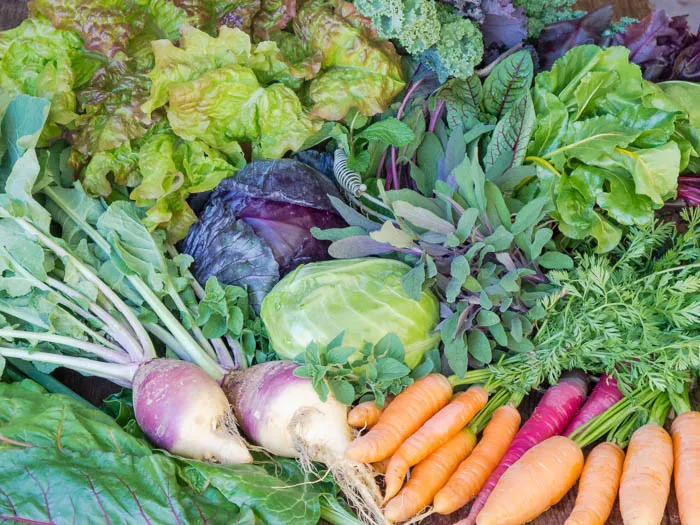
By Kathy Torres
If you have ever enjoyed a BLT with fresh tomatoes from your garden, you probably agree, it is good beyond words! Although you can still buy vine ripe tomatoes in the grocery store throughout the year, it’s just not the same. Unfortunately, it’s getting a little late for tomato plants, however there are other vegetable plants that can be started now that will give you fresh vegetables throughout fall and maybe even winter. Though cool-season crops continue to grow well past the earliest freeze in the fall, they should be started early enough to mature before hard freezes are expected. Some vegetables, like collards and parsnips, are known to have better flavor if grown in cooler weather. December 21st is the first day of Winter 2024, so you have plenty of time to get started if you get busy now. If you are interested in planting seeds, see the Clemson Home & Garden Fact Sheet (Click HERE) for guidelines on when to plant along with estimated days until harvest.
According to the Farmer’s Almanac, beets, cauliflower, celery, green onions, potatoes, Bibb and lettuce, mustard greens, parsnips, radishes, spinach and Swiss chard can survive light frosts in the 30-32° range and are considered “frost tolerant.” “Frost hardy” vegetables that can survive temperatures as low as 20°, include cabbage, broccoli, Brussels sprouts, carrots, kale, leeks, rutabagas and turnips. Because our Midlands temperatures are typically quite mild, your chances are good for a successful cool season garden. It is important to keep an eye on the forecast, however, so you can cover plants that need protection, just in the event of a hard freeze, especially if it is expected to last several days. Not likely, but it has happened!
The Almanac also provides the following guidelines for when to plant. FYI… Predicted first frost for the Columbia area is November 1, but it could be much later than that:
- 10-12 weeks before first frost: broccoli, Brussels sprouts, cabbage, cauliflower, carrots, celery.
- 8-10 weeks before first frost: arugula, Chinese cabbage, collards, kale, lettuce, mustard greens, spinach, Swiss chard, turnips
- 6-8 weeks before first frost: beets, radishes
Like your spring garden, there are certain requirements for a cool weather vegetable garden:
- If you’re planting in the ground, test the soil through Clemson Extension Service (application available at Wingard’s). If you’re reading this on September 1, you don’t have time to wait for soil test results, so consider a raised bed garden to make sure of the best possible soil. Fill the bed with Daddy Pete’s Raised Bed Mix.
- Plant in a location that receives a minimum of six hours of sun per day.
- If you’re planting in an area which contained your spring garden, add compost to enrich the existing soil.
- You won’t have to water as much in cooler weather, but it’s still necessary to have a nearby water source. Don’t let soil get too dry.
- Have a beach umbrella ready, so if we have 90+ degree days you can shade your young seedling from the brutal summer sun.
- Fertilize with ferti-lome Gardener’s Special, according to directions on the back of the bag.
Try your luck with growing herbs in fall and winter. Because the ground does not freeze, they will do ok, however, you’ll need to cover them during a frost or freeze. Note: be sure to uncover during the day when the temperature rises. Rosemary is the exception to the rule…it can survive year ‘round here.
It’s also time for chrysanthemums, pansies and snapdragons. Think about making your fall vegetable garden more attractive by adding a few fall annuals for color.
Usually, pests and disease are minimal during cooler weather, but be on the lookout and treat as necessary if you encounter a problem. A good product to use on Fall gardens to combat, insects, mites and fungus is ferti-lome Triple Action. It is not recommended in the summer because it is oil-based and can burn plants when the temperature is above 85 degrees.
Cool weather vegetable plants are arriving weekly at Wingard’s, so come in and make your selection. If you have any questions, talk with a helpful Wingard’s greenhouse staff member. For additional information on fall vegetable gardening see this Clemson Home & Garden Fact Sheet, as well as other noted Fact Sheet links for specific vegetables HERE.
In summer, a BLT hits the spot. In fall and winter, a salad made of fresh greens or a warm cup of broccoli and cheese soup creates equal satisfaction. Enjoying your own, home-grown collards on New Year’s Day, well, that may just win the grand prize!

